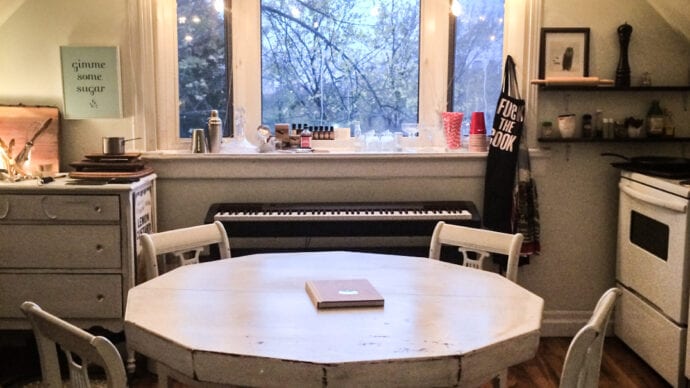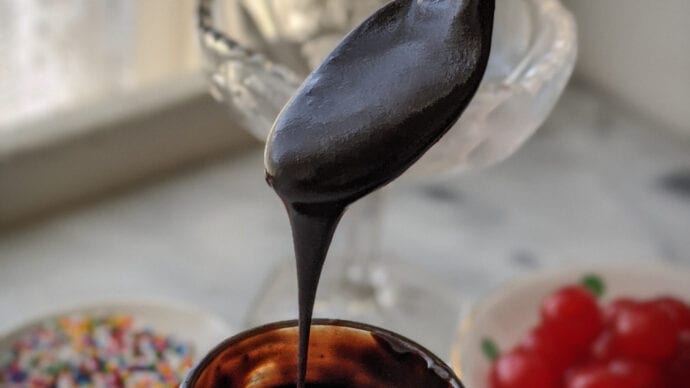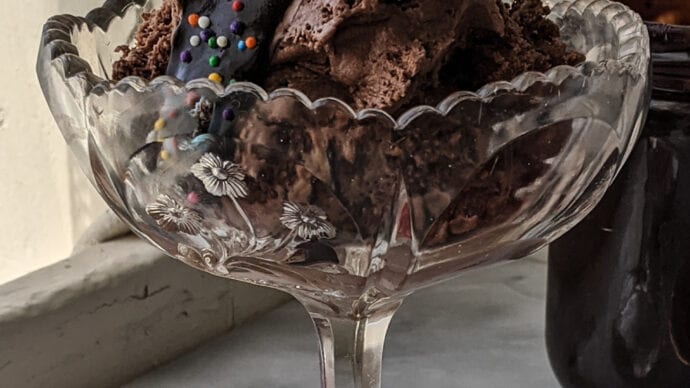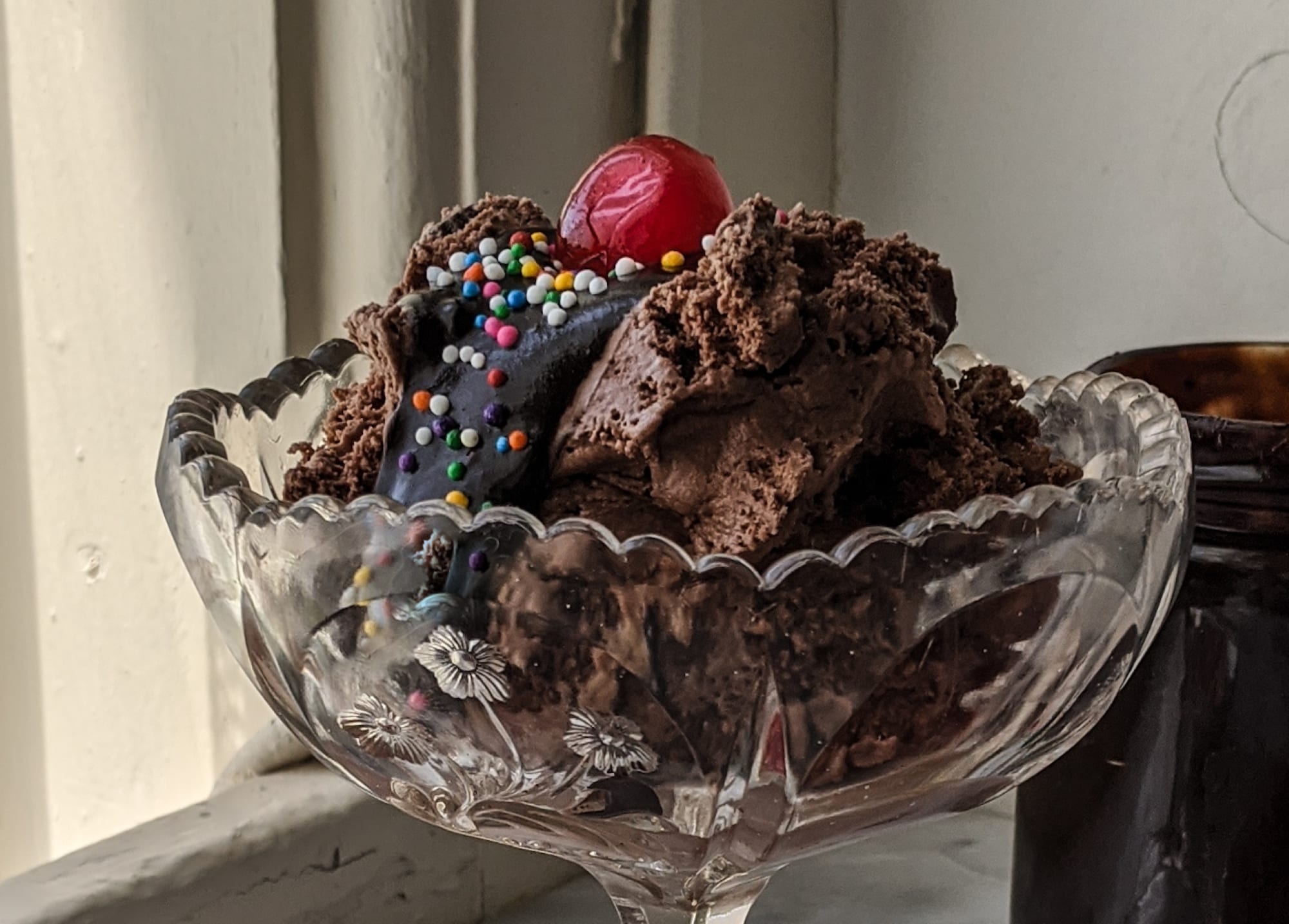This story is part of My Queer Kitchen with Jennifer E. Crawford: Pandemic Edition, a cooking series promoting community, ingenuity and delectability during the time of COVID-19.
Tears come at unpredictable times these days. Sometimes, all it takes is a mass-email with the subject line: “The kitchen table is lonely, right?” Oof. Is my kitchen table lonely?
I didn’t have a kitchen table until two weeks ago, when my partner and I pulled the dining room table into the kitchen to create more prep area. It’s been dusted with flour ever since. The table’s original intention was to welcome others into our home this summer, for imagined futures full of food gatherings. I bought it at ReStore in Dartmouth four months ago. “These are fiddling chairs,” said the man who sat down next to me as I considered the purchase. “No silly arms on them to hit your bowing elbow.” He made a fiddling gesture, eyes sparkling, feet keeping an imaginary beat. “Even I could dance on that table, look how sturdy it is.” He slapped it twice, a hearty spank with his big bear paw. Dance on it?! I had to have it.
“I’ve sat at lonely kitchen tables before this quarantine. Have you?”
We’re so far away from the usual tables in our lives: conference tables, back-of-house galvanized steel tables, school cafeteria tables, co-working tables, restaurant tables. With all those other tables emptied, our kitchen and dining tables are, for many, the mission control of our lives. They anchor our learning, working, cooking and eating. For some, these might be sites of comforting memories and nostalgia—the image of nurturing parents and happy kids gathering around the table embedded in our consciousness from thousands of advertisements, movies, television. Some feel naturally oriented toward that scenario. While for others, a kitchen table might already be a site of loneliness and disorientation.
I’ve sat at lonely kitchen tables before this quarantine. Have you? To many, this experience is nothing new. A table may be fully seated, but the tension between those assembled might be so thick as to render them worlds apart. Decades of unspoken intergenerational trauma somehow lead the conversation, and financial anxiety seasons the meal while quiet, disapproving glances are thrown if you take seconds, munching on eggshells so as to not draw attention to yourself. I keep thinking of all the queer kids in unsupportive homes who are having to sit at tables like that, through this quarantine and beyond. I really want them to know I am rooting for them every day, and remind them that there are better kitchen tables ahead.
In my first apartment that felt like home, the kitchen table was its juicy beating heart. It was gifted to me by two lesbians in my swing dancing group (!) who refused to take any money for it; a table pre-seasoned with warm and generous queer history. A teak pedestal dodecagon, a 12-sided marvel—I’d never seen anything like it. Another queer pal and I sweated as we lugged it up the three narrow flights of stairs to my bachelor apartment, scarcely making the narrow corners so common in old Toronto homes. I called that home “The Fruit Locker.” It was a name borrowed from Polari, a queer slang mainly used by gay British men in the 19th and 20th centuries.

If this table was put into a museum, the label would read, “Jennifer’s Queer Table: The Fruit Locker, Toronto, 2011-2015.” Credit: Jennifer E. Crawford
Lovingly refinished with a distressed white, that table was the site of queer culinary revelry for four glorious years—hilarious tasting menus, queer Maritime kitchen parties, opulent Ice Cream Socials with an unforgettably decadent hot fudge sauce, whole roast suckling pig to celebrate a chosen family reunion and too many cream puffs to count. Lush pleasures all for their own sake—whether alone or in the company of others. Documenting queer histories and objects is a wild challenge, but if I could, that kitchen table would be an artefact and given its own Helvetica-printed label on a museum wall: “Jennifer’s Queer Table: The Fruit Locker, Toronto, 2011-2015.” It was the first kitchen table that didn’t feel lonely to me.
Our well-worn daily habits are presently rendered obsolete, and we’re instead forging new commutes—whether it’s to the kitchen table or to the nest we’ve created on the couch. Trudging our own paths and destinies into existence isn’t new for queer folks. Have you ever seen the paths cut through parks, boulevards and campuses that deviate from the paved walkways? These informal paths are called “desire lines”—a public archive of casual disobedience, an expression of a wish for a new way. They may be repeatedly trampled grass, the well-worn cruising paths in the brush behind a popular beach, a repeatedly corrected pronoun or the gentle scrape of our table across the floor as we move it to the kitchen and back again. Every day, we are making new ways where there were none.
Our desire lines will organically find their way through our homes and across our kitchen tables where things collect. New commutes mean new piles of our necessities for the day, and kitchen tables are turned into offices, schools or recording studios—yet they remain places for connecting. If the kitchen table feels lonely right now, that makes sense: Disorientation is often like that, a genuinely spatial confusion about how to be when there’s no clear path. That’s okay.
“I’d like to loan you this memory and recipe of queer delight.”
Embracing that confusion, I’ve been reminiscing about the energy of my first really queer kitchen table. I’ll never forget the nurturing comfort that came with watching my friends wide-eyed and spooning homemade hot fudge over a mile-high sundae, gathered around a table made possible by queer generosity and hospitality. Seeing the heat carve its own lines of desire down the ice cream, creating puddles of delight and enjoyment, I hold my loneliness close and those memories even closer. I’d like to loan you this memory and recipe of queer delight, gathering around our kitchen tables apart, the blue-light glow of our phones or laptop screens are our new candlelight, connected in our solitude.
Check out Jennifer E. Crawford’s latest recipe below, where they make the perfect sticky, chocolatey hot fudge sauce for all your summer ice cream sundaes.
Hot Fudge Sauce

I spent most of my life thinking hot fudge sauce was melted chocolate plus cream when, in fact, it’s oozy and beautiful exactly because it has no chocolate (the chocolate would seize up as soon as it touched the cold ice cream). The cocoa with a base note of molasses and a final pinch of flaky salt makes this sauce extra in all the good ways.
Ingredients
1 ¾ cup white sugar
¼ cup molasses
¼ cup all-purpose flour
cup cocoa
2 cups whole milk
¼ cup butter
2 tsp vanilla
Flaky salt, for finishing
Method
- Whisk all of the dry ingredients together in a bowl.
- Combine the milk, vanilla, butter and molasses in a pot over medium heat until the butter is melted and the edges are bubbling.
- Add the dry ingredients to the milk mixture ¼ cup at a time, whisking enthusiastically the whole time!
- Once it’s all incorporated, bring to a boil and cook for about 5 minutes, until the mixture has thickened and you can no longer see any grains of sugar. It should look glossy.
- Remove from heat, and allow to cool completely. Use right away, and after spooning over ice cream, finish with a pinch of flaky salt. Or you can jar and refrigerate. In the fridge, it will stay well for two weeks (if it lasts that long). You can reheat in the microwave or a double boiler as you need it.



 Why you can trust Xtra
Why you can trust Xtra


